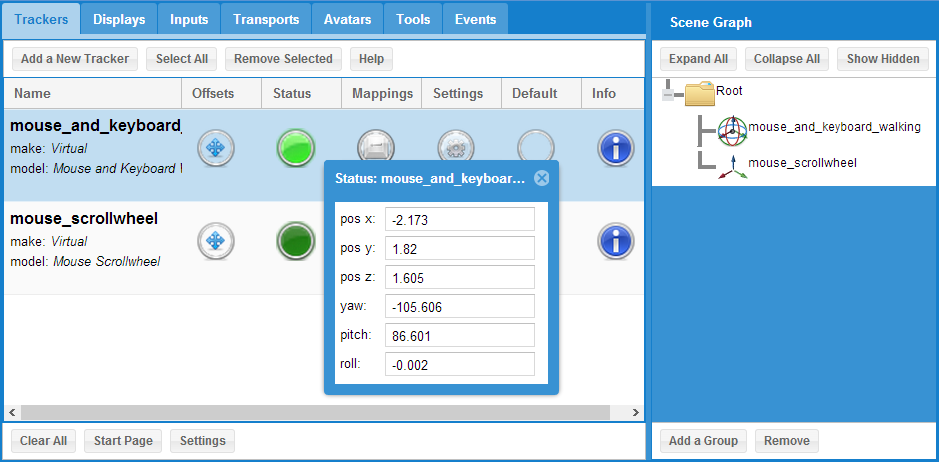Open topic with navigation
Advanced GUI
Use the advanced window to select and configure components individually.

Component Tabs
Hardware Tabs
- :
A tracker reports position and/or orientation information. This can be
a physical device (e.g PPT, inertia cube) or a virtual tracker that simulates
data (e.g. keyboard, mouse)
- :
This can be a standard monitor, 3D monitor, HMD, projection wall, CAVE,
or any other display that Vizard supports.
- :
An input device has some detectable state change or provides some signal
trigger (e.g. button, wand)
Software Tabs
- :
Transports move the user around the environment. They are similar to trackers
in providing position and orientation information. However, transports
are completely virtual. For example, with the transport the user
can point to a location in the environment and fly there in moments. Although
the user has not physically moved, their position in the virtual environment
has been updated.
- :
An avatar represents the user in the virtual environment. The avatar can
be visualized from either a 1st or 3rd person point of view and is animated
using tracking data and inverse kinematics. Optionally the avatar can
be hidden in which case only hand(s) are rendered for tasks such as grabbing.
- :
Virtual objects for manipulating the environment. Tools are designed to
be anything which interacts with the environment. Some
examples of tools include grabbing, measuring, and highlighting.
- :
Events are Vizconnect functions triggered by input signals.
Scene Graph
The scene graph tree displays the component hierarchy. Drag and drop components to modify their parent/child relationships.
Status Window
When an input device, tracker, or transport is the current selection
the Status Window  can be opened. For inputs, the last signal
received from the device is shown. For trackers and transports, the current
position and orientation is shown. This can be helpful to verify that
the connection has been established and the data being sent to Vizard
is accurate.
can be opened. For inputs, the last signal
received from the device is shown. For trackers and transports, the current
position and orientation is shown. This can be helpful to verify that
the connection has been established and the data being sent to Vizard
is accurate.
Generated Code
The Vizard code generated by Vizconnect is saved
to the configuration file. Any time components are added, removed, or
modified the code will automatically update. Manually editing the code is rarely necessary but possible by
opening the file in the Vizard editor. If the code is modified in Vizard
it can be loaded back into the GUI for further editing.
Note: Generally, components are accessed via the script that imports the configuration file.
For example, in order to apply tracking data to a model in the scene,
the programmer would get a handle to the tracker in the script and link
the model to it.

![]() can be opened. For inputs, the last signal
received from the device is shown. For trackers and transports, the current
position and orientation is shown. This can be helpful to verify that
the connection has been established and the data being sent to Vizard
is accurate.
can be opened. For inputs, the last signal
received from the device is shown. For trackers and transports, the current
position and orientation is shown. This can be helpful to verify that
the connection has been established and the data being sent to Vizard
is accurate.